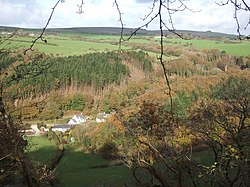Cwm Gwaun
| Cwm Gwaun | |
|---|---|
 |
|
| Cwm Gwaun shown within Pembrokeshire | |
| Population | 313 (2011) |
| Principal area | |
| Ceremonial county | |
| Country | Wales |
| Sovereign state | United Kingdom |
| Post town | Fishguard |
| Postcode district | SA65 9 |
| EU Parliament | Wales |
| UK Parliament | |
| Welsh Assembly | |
Cwm Gwaun (English: Gwaun Valley) is a village and community in northern Pembrokeshire. Located just to the west of Pontfaen hamlet (which is part of the community), it lies 4.3 miles east of Fishguard (Welsh: Abergwaun).
In 2008 the community was reported to have an area of 3,870 hectares and have a population of 266 inhabitants.The Companion Guide to Wales describes Cwm Gwaun as "one of the most important meltwater channels from the last ice age to be found in the British Isles." The River Gwaun rises in the Preseli hills near the village and its tributaries have carved heavily-wooded steep, narrow side-valleys. To the northwest are hills such as Mynydd Dinas and Mynydd Melyn and the valley forms a notable wetland. Trees found in the valley include sessile oak, beech, alder, rowan, ash and willow. The highest point of the Preseli hills is Foel Cwmcerwyn at 535 metres. The area is a notable 5.2 mile (8.32km) nature walk area of the Pembrokeshire Coast National Park. The Rough Guide to Wales says of the community, "Cwm Gwaun and the inland hills Cwm Gwaun, the valley of the burbling River Gwaun is one of the great surprises of Pembrokeshire – a bucolic vale of impossibly narrow lanes, surrounded by the bleak shoulders of bare mountains."
The locals continue to follow the tradition of the pre-1752 Julian calendar and celebrate New Year (Welsh: Hen Galan) on 13 January. Children walk from house to house, and sing traditional Welsh language songs. In return, householders provide gifts, or calennig, of sweets and money. In 2012, it was reported that most children from the local primary school would be absent that day to take part in the celebrations.
...
Wikipedia

